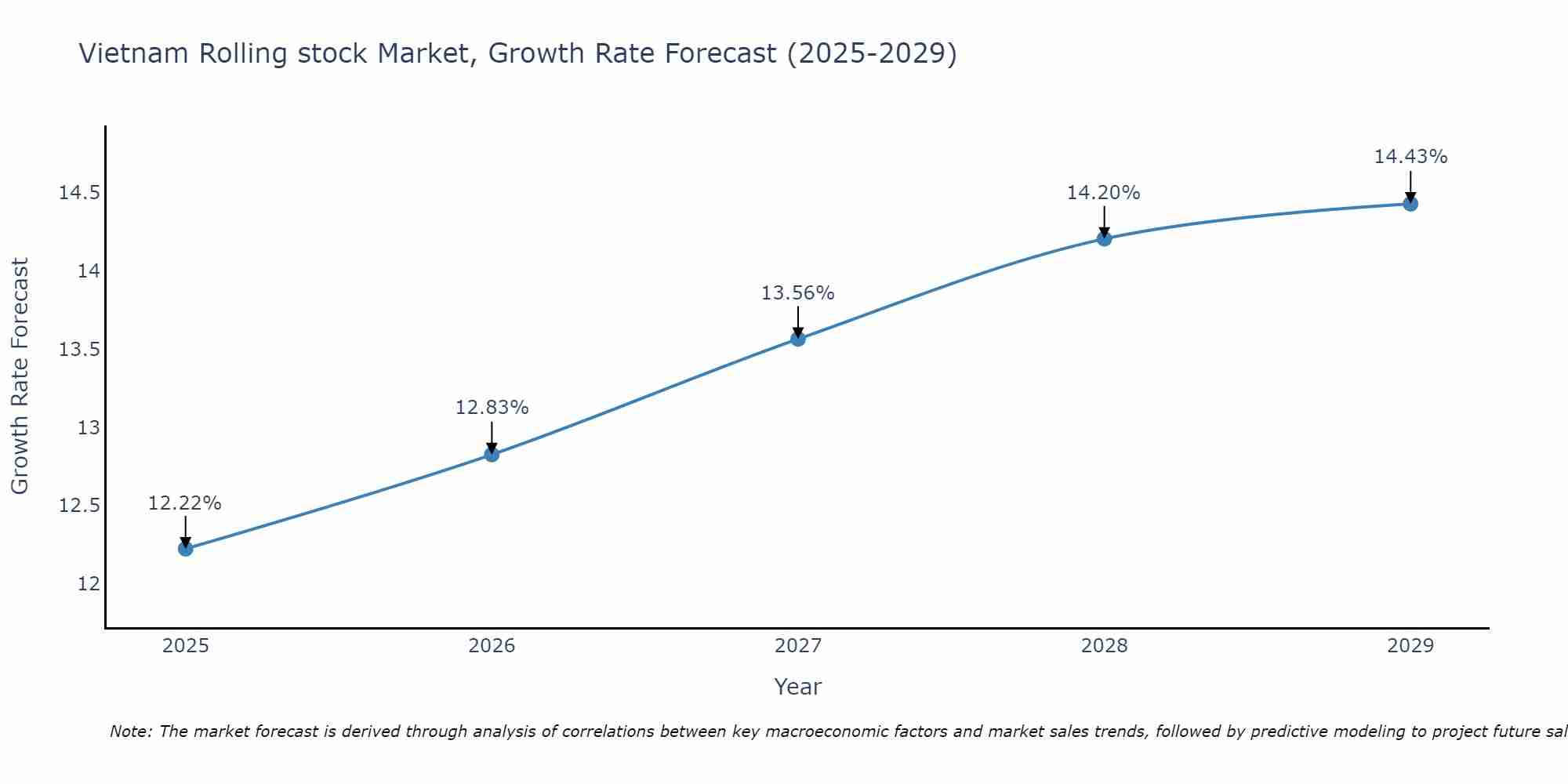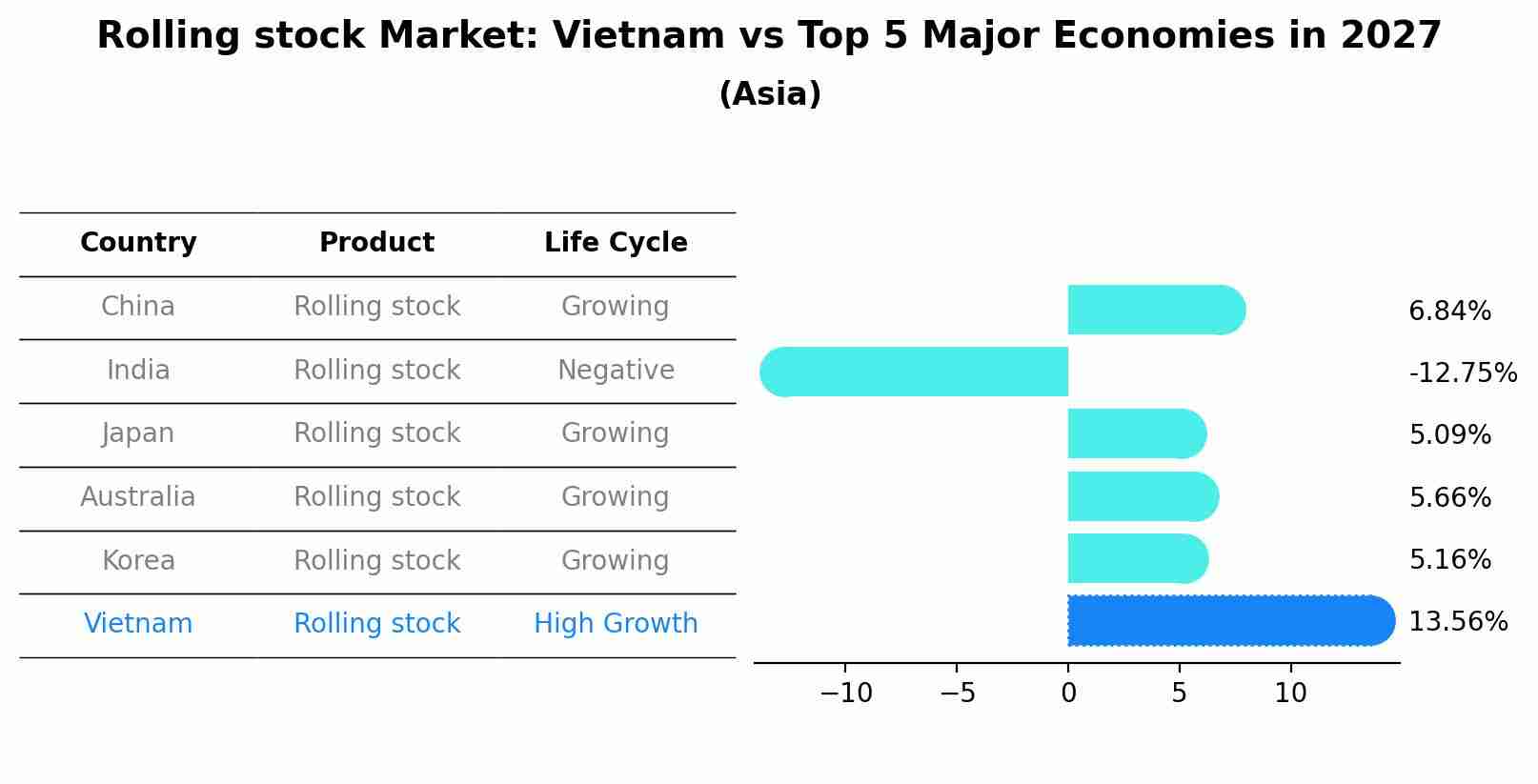Vietnam Rolling stock Market (2025-2031) | Trends, Outlook, Analysis, Industry, Size, Share, Forecast, Value, Companies, Growth & Revenue
| Product Code: ETC027890 | Publication Date: Aug 2023 | Updated Date: Apr 2025 | Product Type: Report | |
| Publisher: 6Wresearch | Author: Ravi Bhandari | No. of Pages: 70 | No. of Figures: 35 | No. of Tables: 5 |
Vietnam Rolling stock Market Size Growth Rate
The Vietnam Rolling stock Market is likely to experience consistent growth rate gains over the period 2025 to 2029. The growth rate starts at 12.22% in 2025 and reaches 14.43% by 2029.

Rolling stock Market: Vietnam vs Top 5 Major Economies in 2027 (Asia)
The Rolling stock market in Vietnam is projected to grow at a high growth rate of 13.56% by 2027, within the Asia region led by China, along with other countries like India, Japan, Australia and South Korea, collectively shaping a dynamic and evolving market environment driven by innovation and increasing adoption of emerging technologies.

Vietnam Rolling stock Market Synopsis
Concerning rolling stock, the Vietnam market has witnessed significant advancements in recent years. With the expansion of the country`s railway network and the government`s efforts to modernize the transportation sector, there has been an increased demand for locomotives, coaches, and other rolling stock equipment. Additionally, the push for more sustainable transportation options has also contributed to the growth of the rolling stock market in Vietnam.
Drivers of the Market
The Vietnam rolling stock market has been witnessing significant advancements, driven by several crucial factors. The government`s focus on developing a more efficient and sustainable transportation network has led to substantial investments in the railway sector. With the expansion of the railway network and the introduction of new routes, the demand for rolling stock, including locomotives and coaches, has increased. The rising need for greener transportation options has further propelled the growth of the rolling stock market, encouraging the adoption of modern and eco-friendly rail vehicles and equipment in Vietnam.
Challenges of the Market
The Vietnam rolling stock market also faces some challenges on its path to growth. As the railway infrastructure expands, there may be constraints in terms of maintenance and operation due to limited expertise and technical capabilities. Developing a skilled workforce to handle the maintenance and repair of rolling stock will be essential to maintain the efficiency and safety of the railway network. Additionally, funding large-scale railway projects can be a challenge, and public-private partnerships might be necessary to secure sufficient investment and ensure timely completion of projects.
COVID-19 Impact on the Market
The Vietnam rolling stock market faced challenges amid the COVID-19 pandemic. The temporary suspension of railway projects and limited operations of existing services impacted the demand for rolling stock during the initial phases. Delays in the delivery of rolling stock from international suppliers due to supply chain disruptions further complicated the situation. However, as the country began to control the spread of the virus and initiated economic recovery efforts, the government`s focus on infrastructure development and sustainable transportation solutions provided opportunities for the rolling stock market to bounce back. With investments in railway expansion and modernization projects, the market witnessed a gradual recovery, although ongoing challenges in logistics and international trade continued to impact the industry.
Key Highlights of the Report:
- Vietnam Rolling stock Market Outlook
- Market Size of Vietnam Rolling stock Market, 2024
- Forecast of Vietnam Rolling stock Market, 2031
- Historical Data and Forecast of Vietnam Rolling stock Revenues & Volume for the Period 2021-2031
- Vietnam Rolling stock Market Trend Evolution
- Vietnam Rolling stock Market Drivers and Challenges
- Vietnam Rolling stock Price Trends
- Vietnam Rolling stock Porter's Five Forces
- Vietnam Rolling stock Industry Life Cycle
- Historical Data and Forecast of Vietnam Rolling stock Market Revenues & Volume By Product for the Period 2021-2031
- Historical Data and Forecast of Vietnam Rolling stock Market Revenues & Volume By Locomotive for the Period 2021-2031
- Historical Data and Forecast of Vietnam Rolling stock Market Revenues & Volume By Metro for the Period 2021-2031
- Historical Data and Forecast of Vietnam Rolling stock Market Revenues & Volume By Monorail for the Period 2021-2031
- Historical Data and Forecast of Vietnam Rolling stock Market Revenues & Volume By Tram for the Period 2021-2031
- Historical Data and Forecast of Vietnam Rolling stock Market Revenues & Volume By Freight Wagons for the Period 2021-2031
- Historical Data and Forecast of Vietnam Rolling stock Market Revenues & Volume By Passenger Coaches for the Period 2021-2031
- Historical Data and Forecast of Vietnam Rolling stock Market Revenues & Volume By Others for the Period 2021-2031
- Historical Data and Forecast of Vietnam Rolling stock Market Revenues & Volume By End Use for the Period 2021-2031
- Historical Data and Forecast of Vietnam Rolling stock Market Revenues & Volume By Passenger Transit for the Period 2021-2031
- Historical Data and Forecast of Vietnam Rolling stock Market Revenues & Volume By Cargo Train for the Period 2021-2031
- Historical Data and Forecast of Vietnam Rolling stock Market Revenues & Volume By Type for the Period 2021-2031
- Historical Data and Forecast of Vietnam Rolling stock Market Revenues & Volume By Diesel for the Period 2021-2031
- Historical Data and Forecast of Vietnam Rolling stock Market Revenues & Volume By Electric for the Period 2021-2031
- Vietnam Rolling stock Import Export Trade Statistics
- Market Opportunity Assessment By Product
- Market Opportunity Assessment By End Use
- Market Opportunity Assessment By Type
- Vietnam Rolling stock Top Companies Market Share
- Vietnam Rolling stock Competitive Benchmarking By Technical and Operational Parameters
- Vietnam Rolling stock Company Profiles
- Vietnam Rolling stock Key Strategic Recommendations
Frequently Asked Questions About the Market Study (FAQs):
1 Executive Summary |
2 Introduction |
2.1 Key Highlights of the Report |
2.2 Report Description |
2.3 Market Scope & Segmentation |
2.4 Research Methodology |
2.5 Assumptions |
3 Vietnam Rolling stock Market Overview |
3.1 Vietnam Country Macro Economic Indicators |
3.2 Vietnam Rolling stock Market Revenues & Volume, 2021 & 2031F |
3.3 Vietnam Rolling stock Market - Industry Life Cycle |
3.4 Vietnam Rolling stock Market - Porter's Five Forces |
3.5 Vietnam Rolling stock Market Revenues & Volume Share, By Product, 2021 & 2031F |
3.6 Vietnam Rolling stock Market Revenues & Volume Share, By End Use, 2021 & 2031F |
3.7 Vietnam Rolling stock Market Revenues & Volume Share, By Type, 2021 & 2031F |
4 Vietnam Rolling stock Market Dynamics |
4.1 Impact Analysis |
4.2 Market Drivers |
4.3 Market Restraints |
5 Vietnam Rolling stock Market Trends |
6 Vietnam Rolling stock Market, By Types |
6.1 Vietnam Rolling stock Market, By Product |
6.1.1 Overview and Analysis |
6.1.2 Vietnam Rolling stock Market Revenues & Volume, By Product, 2021-2031F |
6.1.3 Vietnam Rolling stock Market Revenues & Volume, By Locomotive, 2021-2031F |
6.1.4 Vietnam Rolling stock Market Revenues & Volume, By Metro, 2021-2031F |
6.1.5 Vietnam Rolling stock Market Revenues & Volume, By Monorail, 2021-2031F |
6.1.6 Vietnam Rolling stock Market Revenues & Volume, By Tram, 2021-2031F |
6.1.7 Vietnam Rolling stock Market Revenues & Volume, By Freight Wagons, 2021-2031F |
6.1.8 Vietnam Rolling stock Market Revenues & Volume, By Passenger Coaches, 2021-2031F |
6.2 Vietnam Rolling stock Market, By End Use |
6.2.1 Overview and Analysis |
6.2.2 Vietnam Rolling stock Market Revenues & Volume, By Passenger Transit, 2021-2031F |
6.2.3 Vietnam Rolling stock Market Revenues & Volume, By Cargo Train, 2021-2031F |
6.3 Vietnam Rolling stock Market, By Type |
6.3.1 Overview and Analysis |
6.3.2 Vietnam Rolling stock Market Revenues & Volume, By Diesel, 2021-2031F |
6.3.3 Vietnam Rolling stock Market Revenues & Volume, By Electric, 2021-2031F |
7 Vietnam Rolling stock Market Import-Export Trade Statistics |
7.1 Vietnam Rolling stock Market Export to Major Countries |
7.2 Vietnam Rolling stock Market Imports from Major Countries |
8 Vietnam Rolling stock Market Key Performance Indicators |
9 Vietnam Rolling stock Market - Opportunity Assessment |
9.1 Vietnam Rolling stock Market Opportunity Assessment, By Product, 2021 & 2031F |
9.2 Vietnam Rolling stock Market Opportunity Assessment, By End Use, 2021 & 2031F |
9.3 Vietnam Rolling stock Market Opportunity Assessment, By Type, 2021 & 2031F |
10 Vietnam Rolling stock Market - Competitive Landscape |
10.1 Vietnam Rolling stock Market Revenue Share, By Companies, 2024 |
10.2 Vietnam Rolling stock Market Competitive Benchmarking, By Operating and Technical Parameters |
11 Company Profiles |
12 Recommendations |
13 Disclaimer |
- Single User License$ 1,995
- Department License$ 2,400
- Site License$ 3,120
- Global License$ 3,795
Search
Thought Leadership and Analyst Meet
Our Clients
Related Reports
- Canada Oil and Gas Market (2026-2032) | Share, Segmentation, Value, Industry, Trends, Forecast, Analysis, Size & Revenue, Growth, Competitive Landscape, Outlook, Companies
- Germany Breakfast Food Market (2026-2032) | Industry, Share, Growth, Size, Companies, Value, Analysis, Revenue, Trends, Forecast & Outlook
- Australia Briquette Market (2025-2031) | Growth, Size, Revenue, Forecast, Analysis, Trends, Value, Share, Industry & Companies
- Vietnam System Integrator Market (2025-2031) | Size, Companies, Analysis, Industry, Value, Forecast, Growth, Trends, Revenue & Share
- ASEAN and Thailand Brain Health Supplements Market (2025-2031) | Strategy, Consumer Insights, Analysis, Investment Trends, Opportunities, Growth, Size, Share, Industry, Revenue, Segments, Value, Segmentation, Supply, Forecast, Restraints, Outlook, Competition, Drivers, Trends, Demand, Pricing Analysis, Competitive, Strategic Insights, Companies, Challenges
- ASEAN Bearings Market (2025-2031) | Strategy, Consumer Insights, Analysis, Investment Trends, Opportunities, Growth, Size, Share, Industry, Revenue, Segments, Value, Segmentation, Supply, Forecast, Restraints, Outlook, Competition, Drivers, Trends, Demand, Pricing Analysis, Competitive, Strategic Insights, Companies, Challenges
- Europe Flooring Market (2025-2031) | Outlook, Share, Industry, Trends, Forecast, Companies, Revenue, Size, Analysis, Growth & Value
- Saudi Arabia Manlift Market (2025-2031) | Outlook, Size, Growth, Trends, Companies, Industry, Revenue, Value, Share, Forecast & Analysis
- Uganda Excavator, Crane, and Wheel Loaders Market (2025-2031) | Strategy, Consumer Insights, Analysis, Investment Trends, Opportunities, Growth, Size, Share, Industry, Revenue, Segments, Value, Segmentation, Supply, Forecast, Restraints, Outlook, Competition, Drivers, Trends, Demand, Pricing Analysis, Competitive, Strategic Insights, Companies, Challenges
- Rwanda Excavator, Crane, and Wheel Loaders Market (2025-2031) | Strategy, Consumer Insights, Analysis, Investment Trends, Opportunities, Growth, Size, Share, Industry, Revenue, Segments, Value, Segmentation, Supply, Forecast, Restraints, Outlook, Competition, Drivers, Trends, Demand, Pricing Analysis, Competitive, Strategic Insights, Companies, Challenges
Industry Events and Analyst Meet
Whitepaper
- Middle East & Africa Commercial Security Market Click here to view more.
- Middle East & Africa Fire Safety Systems & Equipment Market Click here to view more.
- GCC Drone Market Click here to view more.
- Middle East Lighting Fixture Market Click here to view more.
- GCC Physical & Perimeter Security Market Click here to view more.
6WResearch In News
- Doha a strategic location for EV manufacturing hub: IPA Qatar
- Demand for luxury TVs surging in the GCC, says Samsung
- Empowering Growth: The Thriving Journey of Bangladesh’s Cable Industry
- Demand for luxury TVs surging in the GCC, says Samsung
- Video call with a traditional healer? Once unthinkable, it’s now common in South Africa
- Intelligent Buildings To Smooth GCC’s Path To Net Zero


















